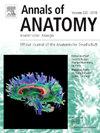CT imaging analysis of the C7 pedicle and lateral mass in children aged 0–14 years
IF 2
3区 医学
Q2 ANATOMY & MORPHOLOGY
引用次数: 0
Abstract
Background and objective
There is currently a lack of anatomical research on the C7 pedicle and lateral mass in children aged 0–14 years, and experience with pediatric lower cervical spine surgeries remains limited. This study aims to investigate the anatomical structure of the C7 pedicle and lateral mass in a large pediatric sample to understand their growth patterns, providing imaging and anatomical references for pediatric lower cervical spine surgeries and the design of pediatric C7 screws.
Methods
We measured 12 parameters, including the width, length, height, and angles of the C7 pedicle and lateral mass in children aged 0–14 years. The t-test was used to analyze bilateral and gender differences, and least squares regression was applied for curve fitting analysis.
Results
The size parameters of the C7 pedicle and lateral mass generally increased with age, while angular parameters fluctuated within specific ranges. The average values for each parameter between ages 0–14 were as follows: D1: 2.78–5.28 mm, D2: 18.15–30.54 mm, D3: 2.44–6.01 mm, angle A: 38.05–44.48°; D4: 6.81–10.94 mm, D5: 5.37–11.23 mm, D6: 8.07–13.28 mm, D7: 1.94–4.88 mm, D8: 5.67–9.39 mm, angle C: 18.50–28.80°, angle D: 43.23–52.01°, angle E: 33.74–44.96°. Bilateral analysis showed no significant differences for most parameters across most age groups, with differences mainly observed in angle A, angle C, D6, and D8. Gender differences were primarily noted in length parameters across different age groups, especially in the 3–4, 6–7, 9–11, and 13–14 age groups. Regression analysis indicated that most parameters followed cubic function curves, while a few followed power or quadratic function curves.
Conclusion
This study provides detailed CT imaging anatomy of the C7 pedicle and lateral mass in children aged 0–14 years. Preoperative thin-slice CT scans and careful measurements of key parameters are essential for pediatric lower cervical spine surgeries. The findings offer valuable imaging and anatomical references for pediatric posterior cervical fixation surgery and screw design.
0 至 14 岁儿童 C7 骨盆和外侧肿块的 CT 成像分析。
背景和目的:目前缺乏对0至14岁儿童C7椎弓根和侧块解剖结构的研究,小儿下颈椎手术经验仍然有限。本研究旨在调查大量儿科样本中C7椎弓根和侧块的解剖结构,了解其生长模式,为儿科下颈椎手术和儿科C7螺钉的设计提供影像学和解剖学参考:我们测量了0至14岁儿童C7椎弓根和侧块的宽度、长度、高度和角度等12个参数。采用t检验分析双侧和性别差异,并应用最小二乘法回归进行曲线拟合分析:结果:C7椎弓根和侧块的尺寸参数一般随年龄增长而增加,而角度参数则在特定范围内波动。0-14 岁期间各参数的平均值如下:D1:2.78-5.28mm,D2:18.15-30.54mm,D3:2.44-6.01mm,角度 A:38.05-44.48°:38.05-44.48°;D4:6.81-10.94mm,D5:5.37-11.23mm,D6:8.07-13.28mm,D7:1.94-4.88mm,D8:5.67-9.39mm,C 角:18.50-28.80°,D 角:43.23-52.01°,E 角:33.74-44.96°。双侧分析表明,大多数年龄组的大多数参数无明显差异,差异主要体现在 A 角、C 角、D6 和 D8。不同年龄组的性别差异主要体现在长度参数上,尤其是 3-4、6-7、9-11 和 13-14 年龄组。回归分析表明,大多数参数遵循三次函数曲线,少数遵循幂函数或二次函数曲线:本研究提供了0至14岁儿童C7椎弓根和侧肿块的详细CT成像解剖结构。术前薄层 CT 扫描和关键参数的仔细测量对小儿下颈椎手术至关重要。研究结果为小儿颈椎后路固定手术和螺钉设计提供了有价值的成像和解剖学参考。
本文章由计算机程序翻译,如有差异,请以英文原文为准。
求助全文
约1分钟内获得全文
求助全文
来源期刊

Annals of Anatomy-Anatomischer Anzeiger
医学-解剖学与形态学
CiteScore
4.40
自引率
22.70%
发文量
137
审稿时长
33 days
期刊介绍:
Annals of Anatomy publish peer reviewed original articles as well as brief review articles. The journal is open to original papers covering a link between anatomy and areas such as
•molecular biology,
•cell biology
•reproductive biology
•immunobiology
•developmental biology, neurobiology
•embryology as well as
•neuroanatomy
•neuroimmunology
•clinical anatomy
•comparative anatomy
•modern imaging techniques
•evolution, and especially also
•aging
 求助内容:
求助内容: 应助结果提醒方式:
应助结果提醒方式:


